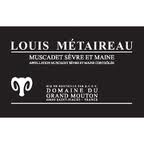Louis Metaireau, Muscadet de Sèvre et Maine (Loire Valley, France) Sur Lie, Domaine de Grand Mouton “Carte Noir” 2010 (Martine’s Wines, $16): Thinking back on it, two of the most memorable wine-tastings that I have attended over the past year have been tastings of Muscadet. They featured some seriously good wines but more significantly than that, these tastings upset pre-conceptions. Muscadet — the fairly light, dry unoaked white wine from the coastal part of France’s Loire Valley region — is not, as many believe, a simple or insignificant wine, but in fact, a wine to be taken seriously by those who love wine.
In recent years, the concept of Muscadet has become more complex, with the availability of older wines, wines from several regional appellations, and wines from specific terroirs. Besides the basic Muscadet AOC, you can find wines from the Sèvre et Maine regional appellation, the Muscadet Coteaux de la Loire region and the Muscadet Côtes de Grandlieu area; you can also find wines designated “Crus Communeaux” from specific sites given official recognition just last year. As a result, you can encounter Muscadet wines that are rounder in style than what we used to know, or riper and softer, or more complex in taste, particularly in mineral complexity, or richer with age. Muscadet is no longer a one-size-fits-all wine.
Louis Metaireau is a family winery in the Sèvre et Maine area. Its main estate is Grand Mouton, which encompasses 56-acres of vines dating back  to 1937. This particular wine, “Carte Noir,” comes from a vineyard on mainly granite soil, where the grapes are harvested later than any of the family’s other grapes. The company has produced “Carte Noir” (a.k.a. “Black Label”) for more than 60 years and considers this the classic wine of the domaine.
to 1937. This particular wine, “Carte Noir,” comes from a vineyard on mainly granite soil, where the grapes are harvested later than any of the family’s other grapes. The company has produced “Carte Noir” (a.k.a. “Black Label”) for more than 60 years and considers this the classic wine of the domaine.
Stylistically, this wine is a hybrid between the classic lean, crisp Muscadet style and the riper, richer style that is emerging from some areas. The ripeness and richness here seem to be due to the particular soil, later harvesting and careful viticulture, resulting in good weight in the wine — as well as to the general quality of the 2010 vintage. And yet this richness does not sacrifice the trademark sleekness and minerality of Muscadet.
The wine has aromas and flavors of ripe apple, nutmeg, grapefruit and particularly a smoky/flinty character. In texture, the wine shows a spritz of carbon dioxide when it is freshly poured (the result of its aging on the fermentation lees), complemented by a weighty, somewhat oily character. It’s a medium-bodied white wine, which is to say rather big for Muscadet. Its flavors show good concentration and strong length across your palate, and the wine’s finish is long and rich. Through the whole tasting experience, this wine emanates a mineral essence that is impressive.
Although this wine is easy enough to quaff, it will reward more thoughtful drinking. Raw oysters and steamed mussels are obvious food partners for this Muscadet. But I also like it with Brie, which can be so challenging for wine; the Muscadet’s minerality sings through the taste of that cheese. And fresh chevre, the wine’s oily texture contrasting with the tanginess of the cheese. Smoked ham and smoked salmon, too — even at brunch, because after all, this wine weighs in at a modest 12 percent alcohol.
90 Points
